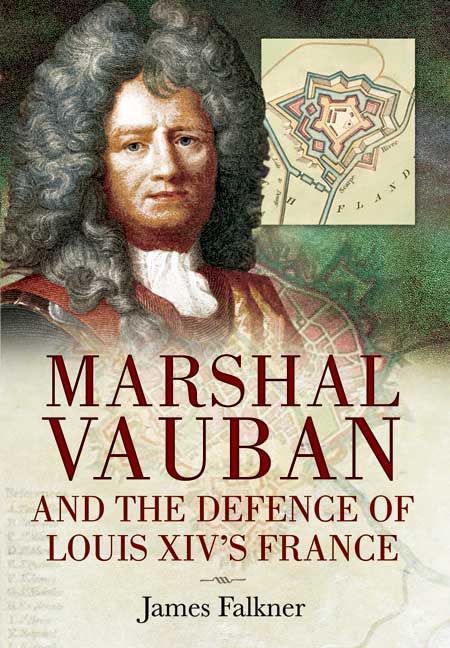Marshal Vauban and the Defence of Louis XIV's France (ePub)
Imprint: Pen & Sword Military
File Size: 3.4 MB (.epub)
Pages: 256
Illustrations: 75 colour & black and white
ISBN: 9781783031337
Published: 25th July 2011
| Other formats available | Price |
|---|---|
| Marshal Vauban and the Defence… Paperback Add to Basket | £19.99 |
Marshal Vauban was one of the greatest military engineers of all time. His complex, highly sophisticated fortress designs, his
advanced theories for the defence and attack of fortified places, and his prolific work as a writer and radical thinker on military and social affairs mark him out as one of the most influential military minds of the late seventeenth and early eighteenth centuries. Yet no biography of this extraordinary man has been published in English in recent times.
James Falkner, in this perceptive and lively new account of Vauban's life and work, follows his career as a soldier from a dashing and brave young cavalryman to his emergence as a masterful and innovative military engineer. He shows that Vauban was much more than simply a superlative builder of fortresses, for as a leading military commander serving Louis XIV he perfected a method for attacking fortifications in the most effective way, and at least cost, which became standard practice until the present day. Indeed, in the 1670s his standing was such that Louis XIV gave him the task of fortifying the newly enlarged French borders in order to secure the king's conquests in that otherwise indefensible region.
Vauban's work in the decades that followed in designing, constructing and improving over 150 fortresses across France, Belgium, Luxembourg, and northern Italy, along the Rhine and in the Pyrenees and on France's long coastline, made him the preeminent military engineer of his day. His achievements in those years are the bedrock for all subsequent military engineering
activity, and his written works remain unsurpassed as practical handbooks and guides in the formal art of siegecraft.
James Falkner's new study will add significantly to the understanding of Vauban's achievements and the impact his work has had on the history of warfare.
"This book offers excellent insight into the period, siege craft, and the man. Enjoyed it"
The Historical Miniatures Gaming Society
Read the full review here
As featured in.
Military History Magazine
“The emphasis and focus of the book, understandably given the background of both author and publisher (and likely readership), is very clearly the wars and campaigns which were the background to Vauban’s activity, and the fortification and sieges which made up the latter.”
War In History, Christopher Storrs
“This is a very enjoyable read for those looking for a good, basic account of Vauban’s career and his role in the wars of Louis XIV and of fortification more generally. Its usefulness is enhanced by various maps and reproductions of portraits of key characters and of contemporary plans of fortresses.”
Falkner's book should appeal to all enthusiasts of military history.
Thomas Zacharis
James Falkner's biography of Marshal Sebastien Le Prestre de Vauban traces his life from student to the master of the craft of military engineering and at the same time details the conquests of Louis XIV. Vauban's skills were critical to France and its ability to defend its borders in a tumutuous period of Europe's history. The author is a well-respected Malborough historian and as a result, John Churchill does appear more often than is probably necessary (he is indeed indexed more than Conde, Louvois, Luxembourg, Turenne or Villars). As a result, there is a War of the Spanish Succession bias. The quality of the illustrations is very good (it is nice to see Blomfield's c1936 sketches reproduced) though more plates would have been welcome. The maps and plans are useful though a location map of the Vauban sites is a notable omission. I would recommend IGN's La France de Vauban map here. Unsurprisingly, most of the contemporary plans date form the War of the Spanish Succession. Falkner claims more than once that a cheif reason for the decline in the quality of French infantry during the period was due to their use as labourers and pioneers, implying that this was exceptional - yet labouring was the lot of the infantryman from Roman times to the 21st century. Falkner's discussion of the development of ricochet artillery fire is excellent - a development that typified Vauban's hallmarks of efficiency and effectiveness.
Casemate: The Fortress Study Group
The map demonstrating France's vulnerability to attack is admirable (a good illustration of De Gaulle's Fatal Avenue). The map of the Pre Carre, (which Falkner describes as Vauban's Fence of Iron, a term associated with Sere de Rivieres who coined the phrase Barriere de Fer in the 19th century), would be a useful addition if it was not too small and somewhat misleading - for instance it included Boulogne, even though the town does not include any Vauban defences. I would agree that the Vauban works in such places as Gravelines and Lille are 'in a fine state'; the same cannot be said of Calais, and on this point the text contradicts the map. Probably the best chapter in the book looks at how Vauban's Pre Carre resisted Allied advances during the War of the Spanish Succession and so saved France. The following chapter considers how Vauban's defences performed in later wars, particularly the Revolutionary and Napoleonic, the Franco-Prussian and both World Wars and is equally good.
The appendices are useful though one lists just the fortresses (including Boulogne) with no indication of their locality and no map to accompany the list. The bibliography is very thorough and very useful however. It is a sold enough biography and a good introduction to Vauban, but unfortunately one that ultimately did not live up to my expectations.
As one who has studied European fortifications for over 30 years, and, as such, has come to [yes, let me use the term, worship] the great works of Marshal Vauban, it was with a very skeptical and defensive eye that I began to read through James Falkner's newest account of, arguably, the greatest military engineer of all time. After my attempts to find error or fault in the first 50 pages (for which I was unsuccessful), I finally settled in and began to thoroughly enjoy his vivid and well written account of the life of the man who built some of the most magnificent military structures known to man.
Clayton Donnell "Fortress Archaeologist"
Being accustomed to reading historical accounts that tend to drone on ad nauseum about minutiae that causes the reader to beg the author to please move on to the good stuff, I found it refreshing, and a relief, that Falkner digs right in to what we want to hear the most about the Marshal, that is, what he did on the battlefields of Louis XIV's late seventeenth century France. Certainly he describes the early life and experiences of Vauban, including his schooling and his family, but this is all the background one needs to know if the reader is interested in what Vauban produced, rather than his life as a boy on the family estate.
The book is laid out in chronological order detailing the conquests of Louis XIV from the 1660s to the early 1700s. We follow the life of Vauban from observer to master of a craft associated with very few men; a craft that was critical to the ability of a nation to defend its borders in the tumultuous period of Europe's history where societies were defined and shaped by war and negotiation. Vauban's genius was not with the sword or the musket, it lay in his ability to view a brick and stone fortress and the fields that extended out from its bastions from a different perspective. His mind was that of an engineer who could spot flaws in the angles and proportions of the works in front of him, or from upon which he viewed an enemy siege. Vauban appears as a major player in each campaign, thus demonstrating the large footprint he left across France and his decisive impact on the expansion of French territory. The book also describes very well the toll this ceaseless schedule took on him, as he was ushered from one place to another, rebuilding a fortress here, laying siege to another there.
My sole (and very minor) criticism of the book is that there are not enough visuals to support the descriptions of the many places accounted of in the book, and for this I only give it 4.99 stars [!]. During the Dutch War it would be helpful to have a map showing the campaign and all of the places discussed in it. To be fair, however, this is not a coffee table book, and the author does an excellent job of bringing the fields of battle to life in the imagination. His descriptions of man and place are vivid and interesting, and it is rare to be able to follow a battle or campaign in one's mind without sketching one's own diagrams and lists of characters.
Marshal Vauban and the Defence of Louis XIV's France, by James Falkner, is a book of military history. However, it is also a socio-political and biographical sketch of Marshal Vauban's France, perpetually at war, and the French court under Louis XIV. However, and the reason it will remain to me a valuable piece of my fortress engineering collection is that it is also a good book about fortresses. Or rather, it is a "treatise" on fortifications and the art of the siege.
Vauban was undoubtedly one of greatest military engineers in history and left a legacy that influenced fortifications and siege warfare for centuries. As Falkner rightly said, “Vauban had died, and his like would not be seen again.” In the service of France, he created in three decades a system known as the “Fence of Iron” to secure the northern frontier. His work eventually extended to all the frontiers of France and its coastal ports. He laid down the groundwork for defence system of France from the North Sea to the Rhine that lasted well into the twentieth century. In addition to building fortifications, Vauban developed siege methods and established guidelines for them. The word “impregnable” was anathema to him even though he created the most impressive forts and fortresses of the era. He was fully conscious of the fact that any of them could be taken.
J.E Kaufman SITEO Newsletter
In his day, it was almost unheard that a man such a modest family background could rise to the status of Marshall of France. In the 1650s, the young Vauban joined Condé’s army in the Fronde—a civil war—fighting against the young King Louis XIV. After he was captured, he joined the royal army and became a loyal servant of the king for the remainder of his life. The king was impressed with Vauban’s skills in siege warfare, but cautioned him not to expose himself to danger in the siege lines, which did not keep him from continuing to take risks. He received numerous rewards from the king who appointed him Marshall of France in 1703. Today, when asked to name a Marshall of France, many can only name a couple who served under Napoleon and about the same number from the World Wars, but almost everyone knows of the great Vauban.
Falkner’s book follows the life of Vauban and covers the many wars of Louis XIV centering on the role of this great military engineer in building fortresses, capturing them, and even reconstructing those he breached. Falkner introduces the reader to the basics of fortress design and Vauban’s guide to siege warfare in which he established the methods and time required to conduct a successful siege. Vauban was involved with work on over 180 fortresses and participated in over 30 sieges. The seventeenth and even much of the eighteen century was dominated by positional warfare in which armies usually maneuvered to engage in a few decisive battles. This period saw the development of a code of conduct more humane than the medieval code of chivalry. A defeated enemy could receive the honors of war and be allowed to march away with weapons in hand and flags flying. If a fortress commander withstood the enemy assault according to Vauban’s guidelines, he was allowed to surrender honorably.
Often to the dismay of his king, Vauban also wrote about other topics such as a fair system of taxation or ways to improve the quality of infantry. He treated his subordinates well, and was not concerned with wealth. All this, and more, is covered by the author. Falkner’s excellent work is a must for anyone with an interest in military history.
This is both an interesting biography of an important figure and a useful account of the main military events of the reign of Louis XIV.
History of War Website
About James Falkner
James Falkner is a leading authority on eighteenth-century warfare and he has made a special study of the military exploits of the 1st Duke of Marlborough. His book, Great and Glorious Days: Marlborough's Battles 1704-1709, is one of the outstanding studies of the subject. His other books include Marlborough’s Wars: Eyewitness Accounts 1702-1713, Marlborough's Sieges, Marlborough's Battlefields, Fire Over the Rock: The Great Siege of Gibraltar 1779-1783, Marshal Vauban and the Defence of Louis XIV’s France, Marlborough’s War Machine, The War of the Spanish Succession, 1701-1714 and The Battle of Fontenoy 1745: Saxe against Cumberland in the War of the Austrian Succession.



















